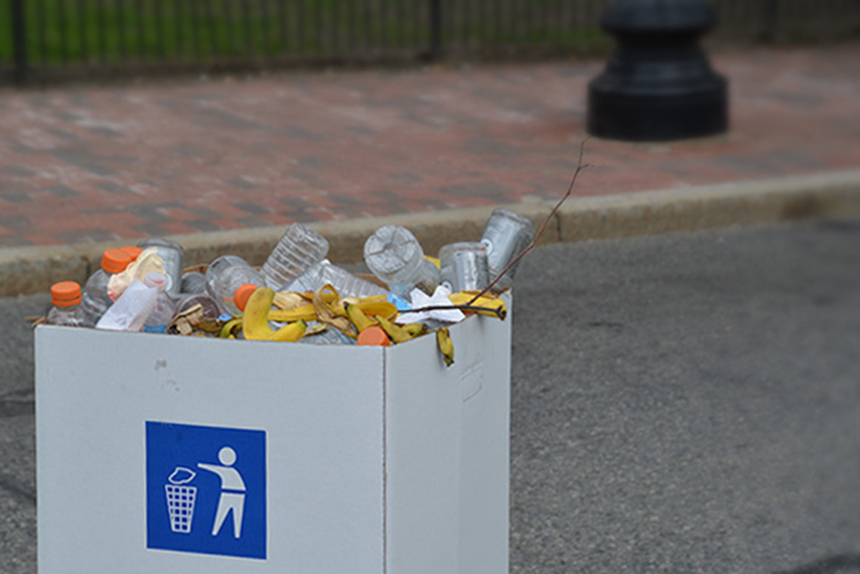Innovative R.I. Pilot Program Tackles Problem of Fiberglass Boat Disposal
But the fiberglass vessel recycling program paused because of a lack of funding
July 24, 2023
NEWPORT, R.I. — We need to talk about fiberglass.
Despite its name, the polymer-infused composite is a plastic-like material, reinforced with glass fibers to make a lighter, stronger, durable, and inexpensive material that can be molded into a variety of complex shapes. The stuff is used to make boats to bathtubs, from swimming pools to septic tanks and from surfboards to wind turbines.
The benefits come at a steep environmental cost; fiberglass does not biodegrade, it does not corrode, and it’s almost impossible to recycle into something else. Recycling programs won’t accept fiberglass products, unlike some traditional plastic counterparts. Shredding, cutting, or breaking apart fiberglass produces silica dust, which if inhaled can scar lung tissue or lead to the development of lung cancer.
As a result, without viable alternatives, most products made of fiberglass can be expected to be landfilled once they reach the end of their life cycle.
But thanks to a little-known pilot program in Rhode Island, that could change.
In 2018, the Rhode Island Marine Trades Association (RIMTA), with Rhode Island Sea Grant, established the Fiberglass Vessel Recycling Pilot Project, designed to tackle the growing problem of what to do with boats once they have been abandoned, declared derelict, or otherwise reached the ends of their typical lifespan — 50 to 60 years on average if regularly maintained.
Currently, almost all boats in Rhode Island are going to end up at a landfill somewhere, someday. Salvage yards can strip them of valuable metals or other parts that could be reused, but because of the fiberglass hulls used almost universally in their construction, there really aren’t any other options to dispose of a boat.
RIMTA’s pilot project coordinated an ad-hoc supply chain of sorts. It worked with marinas and boat owners around the state to dispose of derelict or abandoned boats by shredding their fiberglass hulls. The shredded fiberglass was then shipped to a Holly Hill, S.C., cement manufacturer, where it was used to make cement.
Fiberglass vessels are a problem of growing national attention. The Save Our Seas 2.0 Act, sponsored by Sen. Sheldon Whitehouse, D-R.I., mandated the Environmental Protection Agency and National Oceanic and Atmospheric Administration complete a study about fiberglass recycling.
A $105,000 grant from NOAA’s Marine Debris Program allowed RIMTA to expand its existing project to inform the feasibility of a national program.
“Think of a hurricane situation in Florida or the Carolinas, where there’s just a pile of fiberglass boats washed up on shore. What do you do with them?” said Brian Dursi, executive director of RIMTA. “It could be somebody’s individual boat in the backyard. It could be [in] a marina or boatyard that has a customer that stopped paying for it.”
Up to 65,000 vessels are lost annually due to weather events, and the National Marine Manufacturers Association estimated 177,250 boats were retired in 2016, around 1.5% of the total recreational fleet.
The program, which Dursi called a “proof of concept” program, was a success. According to a report published in February by the RIMTA Foundation, the program recycled 80 short tons of fiberglass material from derelict or abandoned boats into cement.
Recreational boating has seen a post-pandemic boom. More than a million used recreational vessels changed owners in 2020, and another 320,000 new boats were sold during the pandemic.
The catch? Recycling fiberglass is expensive. The NOAA grant money has since run out, and the program is currently on pause, according to Dursi. There were costs at every step of the program, and shredded fiberglass has little-to-no market value.
“We have to pay for the cement kilns to take it off our hands,” Dursi said. “We have to pay somebody to shred the fiberglass, we have to pay somebody to transport it, you have to pay someone to dismantle the boats. The cost of recycling is prohibitive for people that are looking to really just dispose of boats that they don’t want to spend any more money on as is.”
The program’s real future isn’t in boats, said Dursi, but in its practical applications for decommissioning wind turbines.
According to the National Renewable Energy Laboratory (NREL), somewhere around 85% to 90% of a wind turbine’s mass is made of materials able to be recycled. The bulk of materials that are unable to be recycled are composed of fiber-reinforced composites: carbon fiber and fiberglass. The composites are found in various shapes and sizes in the wind blades and the cover for the hub that connects the blades to the turbine.
Earlier this month, NREL launched a $5.1 million competition to develop a cost-effective, sustainable recycling industry to handle those two composites in wind turbines, just as offshore wind turbines begin to really bloom along the Eastern seaboard.
It’s already an issue in Europe, which has had wind turbines for decades. WindEurope, an association of wind turbine manufacturers, suppliers, and renewables associations, has called for a Europe-wide landfill ban on wind turbines.
According to WindEurope, an estimated 25,000 tons of wind turbine blades will reach the end of their operational life annually by 2025, a number that is expected to more than double by 2030, to 52,000 tons annually.
Composites remain a growing problem in Europe. The European Composite Industry Association estimates 40% to 70% of composite materials manufactured in Europe end up in landfills or incinerators. Their preferred solution? Cement co-processing, just like RIMTA organized for Rhode Island.
Dursi sees momentum toward fiberglass recycling, but said a permanent solution is still some distance away. The program remains paused as RIMTA searches for other partnerships or funding sources.
“There’s initiative and momentum there,” Dursi said. “It’s sort of at the infant stages as far as technology, logistics, and costs.”



